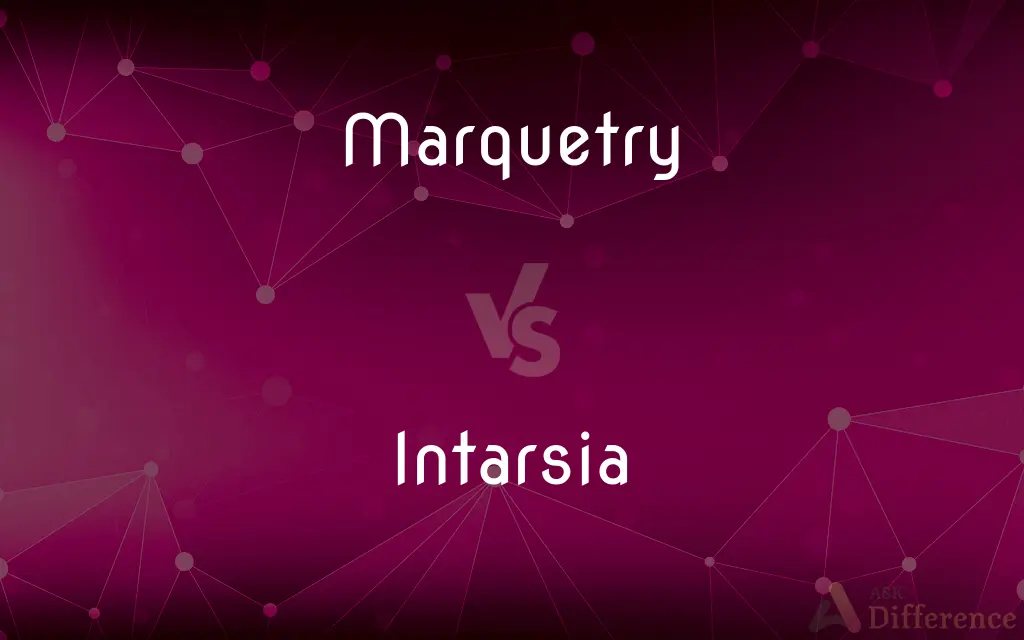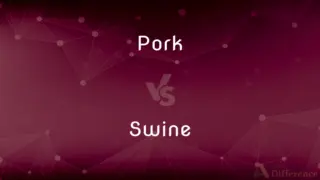Marquetry vs. Intarsia — What's the Difference?
By Urooj Arif & Fiza Rafique — Updated on March 28, 2024
Marquetry involves creating patterns with veneers of wood on surfaces, while Intarsia is about fitting together pieces of wood to form a mosaic-like picture.

Difference Between Marquetry and Intarsia
Table of Contents
ADVERTISEMENT
Key Differences
Marquetry is an art form where thin slices of wood, or veneers, are carefully cut and glued onto a surface to form intricate patterns or pictures. Intarsia, on the other hand, involves creating a picture or pattern from pieces of wood that are cut, shaped, and then fitted together like a jigsaw puzzle.
While marquetry primarily focuses on the surface decoration of objects, creating flat, patterned surfaces, Intarsia offers a more sculptural approach, with pieces often having varying levels of thickness and relief to enhance the three-dimensional effect. This key difference in technique leads to distinct artistic results, with marquetry providing a more refined and detailed surface, whereas Intarsia offers a tactile depth and realism.
Both marquetry and Intarsia require a high degree of precision and artistic skill, but their tools and techniques differ significantly. Marquetry artisans use fine saws and knives to cut veneers, which are then pieced together and glued onto a surface. Intarsia artists, meanwhile, work with thicker pieces of wood, using saws to cut out individual components before fitting and gluing them together to form the final picture.
Despite these differences, marquetry and Intarsia share a common goal: to create beautiful, intricate designs using wood. Both art forms have a long history and have been used to decorate a wide range of objects, from furniture to wall hangings, showcasing the versatility and enduring appeal of wood as a medium for artistic expression.
Comparison Chart
Definition
The art of creating patterns with veneers of wood.
The art of fitting together pieces of wood.
ADVERTISEMENT
Technique
Uses thin slices of wood glued onto a surface.
Uses cut, shaped, and fitted pieces of wood.
Visual Effect
Creates detailed, flat surfaces.
Produces three-dimensional, textured images.
Material Thickness
Utilizes thin veneers.
Employs thicker pieces of wood.
Artistic Focus
Emphasizes intricate patterns and designs.
Focuses on contrast, depth, and texture.
Compare with Definitions
Marquetry
The technique of piecing together veneer patterns.
She specializes in marquetry, creating detailed patterns on jewelry boxes.
Intarsia
Involves fitting together different wood pieces.
Intarsia requires precise cutting to ensure the pieces fit perfectly.
Marquetry
Involves intricate patterns or scenes.
Marquetry often depicts landscapes or historical events in wood.
Intarsia
Uses the natural color and grain of wood.
The intarsia piece utilized walnut and maple woods for contrast.
Marquetry
Primarily decorates flat surfaces.
Marquetry embellished the tabletop with an elegant, geometric pattern.
Intarsia
An art form creating pictures with wood pieces.
The wall featured an Intarsia artwork of a mountainous landscape.
Marquetry
Uses dyed or natural wood veneers.
He used blue-dyed veneers in his marquetry to accentuate the sky.
Intarsia
Creates a 3D visual effect.
The Intarsia bird appeared almost lifelike, thanks to the skilled craftsmanship.
Marquetry
A decorative art form using wood veneers on surfaces.
The antique desk was adorned with exquisite marquetry of floral designs.
Intarsia
Focuses on textured and realistic images.
His Intarsia work often features animals with incredible detail and texture.
Marquetry
Marquetry (also spelled as marqueterie; from the French marqueter, to variegate) is the art and craft of applying pieces of veneer to a structure to form decorative patterns, designs or pictures. The technique may be applied to case furniture or even seat furniture, to decorative small objects with smooth, veneerable surfaces or to freestanding pictorial panels appreciated in their own right.
Intarsia
Intarsia is a form of wood inlaying that is similar to marquetry.
Marquetry
Inlaid work made from small pieces of coloured wood or other materials, used for the decoration of furniture
A restored marquetry table top
Intarsia
A decorative inlaid pattern in a surface, especially a mosaic worked in wood.
Marquetry
Material, such as wood or ivory, inlaid piece by piece into a wood surface in an intricate design and veneered to another surface, especially of furniture, for decoration.
Intarsia
A knitted design resembling a mosaic that is visible on both sides of a fabric.
Marquetry
A decorative technique in which veneers of wood, ivory, metal etc. are inlaid into a wooden surface to form intricate designs.
Strawen marquetry
Intarsia
The art or practice of making intarsias.
Marquetry
(countable) An example of this work.
Intarsia
A decorative form of Italian wood inlaying.
Marquetry
Inlaid veneers are fitted together to form a design or picture that is then used to ornament furniture
Intarsia
(knitting) A knitted design resembling a mosaic.
Common Curiosities
Can marquetry and Intarsia be combined in a single artwork?
Yes, artists sometimes combine marquetry and Intarsia techniques to exploit the strengths of both forms in a single piece.
What is marquetry?
Marquetry is the art of creating decorative patterns or pictures by assembling thin slices of wood veneers onto surfaces.
How time-consuming is Intarsia compared to marquetry?
Both are time-consuming, but Intarsia can be more so due to the complexity of fitting three-dimensional pieces together.
How does Intarsia differ from marquetry?
Intarsia involves creating images by fitting together pieces of wood with varying thickness, resulting in a three-dimensional appearance, unlike the flat patterns of marquetry.
What kind of wood is used in Intarsia?
Intarsia can use a variety of woods, emphasizing natural colors and grains to enhance the artwork's depth and contrast.
What is the history of marquetry?
Marquetry has a rich history dating back to ancient Egypt, but it flourished in 16th-century Italy and France.
How does the choice of wood affect an Intarsia artwork?
The choice of wood greatly affects the artwork's visual appeal, with different grains and colors providing contrast and depth.
Is marquetry only used for decorative purposes?
While primarily decorative, marquetry can also serve to protect surfaces and add value to objects.
What tools are essential for marquetry?
Fine saws, knives, and adhesives are essential tools for creating marquetry.
Do marquetry and Intarsia require special skills?
Yes, both require artistic skill, precision, and a deep understanding of wood properties.
Can I learn marquetry or Intarsia on my own?
With dedication and practice, it is possible to learn either art form through self-study and workshops.
Are there digital techniques for marquetry or Intarsia?
Digital design tools can assist in planning, but the physical creation of both art forms remains a hands-on process.
Can marquetry be repaired if damaged?
Yes, skilled craftsmen can repair marquetry, though matching the original materials and craftsmanship can be challenging.
Are there modern applications of marquetry and Intarsia?
Both forms are used in contemporary furniture design, art, and decoration, blending traditional techniques with modern aesthetics.
What makes Intarsia stand out in woodworking?
Its ability to create lifelike, three-dimensional images using the natural beauty of wood makes Intarsia stand out.
Share Your Discovery

Previous Comparison
Pork vs. Swine
Next Comparison
Butter vs. CreamAuthor Spotlight
Written by
Urooj ArifUrooj is a skilled content writer at Ask Difference, known for her exceptional ability to simplify complex topics into engaging and informative content. With a passion for research and a flair for clear, concise writing, she consistently delivers articles that resonate with our diverse audience.
Co-written by
Fiza RafiqueFiza Rafique is a skilled content writer at AskDifference.com, where she meticulously refines and enhances written pieces. Drawing from her vast editorial expertise, Fiza ensures clarity, accuracy, and precision in every article. Passionate about language, she continually seeks to elevate the quality of content for readers worldwide.
















































